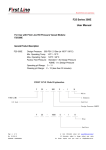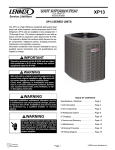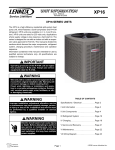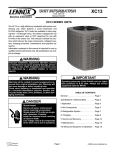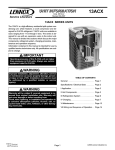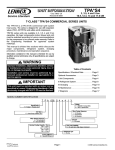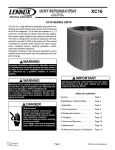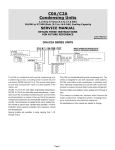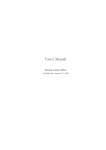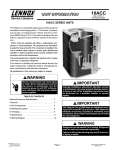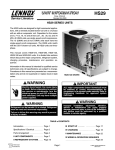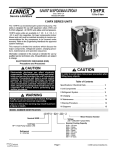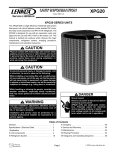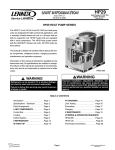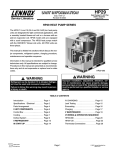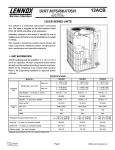Download HPXA12 series
Transcript
Service Literature
Corp. 0208−L3
Revised 09−2004
HPXA12
HPXA12 SERIES UNITS
The HPXA12 is a high efficiency residential split−system
heat pump unit, which features a scroll compressor and
R410A refrigerant. HPXA12 units are available in sizes
ranging from 1 1/2 through 5 tons. The series is designed
for use with an expansion valve only (approved for use with
R410A) in the indoor unit.This manual is divided into sections which discuss the major components, refrigerant system, charging procedure, maintenance and operation sequence.
Information contained in this manual is intended for use by
qualified service technicians only. All specifications are
subject to change.
IMPORTANT
Operating pressures of this R410A unit are higher
than pressures in R22 units. Always use service
equipment rated for R410A.
WARNING
Warranty will be voided if covered equipment is removed from original installation site. Warranty will
not cover damage or defect resulting from:
Flood, wind, lightning, or installation and operation in a corrosive atmosphere (chlorine, fluorine,
salt, recycled waste water, urine, fertilizers, or other damaging chemicals).
TABLE OF CONTENTS
General . . . . . . . . . . . . . . . . . . . . . . . . . . . . . . . . . . . . . . 1
Specifications / Electrical . . . . . . . . . . . . . . . . . . . . . . . . 2
I Unit Information . . . . . . . . . . . . . . . . . . . . . . . . . . . . . . 5
II Unit Components . . . . . . . . . . . . . . . . . . . . . . . . . . . . . 5
III Refrigerant System . . . . . . . . . . . . . . . . . . . . . . . . . . 13
WARNING
IV Charging . . . . . . . . . . . . . . . . . . . . . . . . . . . . . . . . . . . 15
Improper installation, adjustment, alteration, service
or maintenance can cause property damage, personal injury or loss of life. Installation and service must
be performed by a qualified installer or service
agency.
V Service and Recovery . . . . . . . . . . . . . . . . . . . . . . . . 19
VI Maintenance . . . . . . . . . . . . . . . . . . . . . . . . . . . . . . . . 19
VII Wiring Diagram and Operating Sequence . . . . . . 20
WARNING
Electric shock hazard. Can cause injury
or death. Before attempting to perform
any service or maintenance, turn the
electrical power to unit OFF at disconnect switch(es). Unit may have multiple
power supplies.
Page 1
©2002 Lennox Industries Inc.
SPECIFICATIONS single phase
General
D t
Data
Model No.
Nominal Tonnage (kW)
Connections
(sweat)
HPXA12−030
HPXA12−036
2 (7.0)
2.5 (8.8)
3 (10.6)
3/8 (9.5)
3/8 (9.5)
3/8 (9.5)
3/8 (9.5)
Vapor line o.d. − in. (mm)
3/4 (19.1)
3/4 (19.1)
3/4 (19.1)
7/8 (22.2)
7 lbs. 5 oz. (3.31 kg)
6 lbs. 12 oz. (3.06
kg)
7 lbs. 12 oz. (3.51
kg)
8 lbs. 15 oz. (4.1 kg)
18 (457) − 3
18 (457) − 3
18 (457) − 4
18 (457) − 4
1/6 (124)
1/6 (124)
1/6 (124)
1/6 (124)
Diameter − in. (mm) & no. of blades
Motor hp (W)
2500 (1180)
2500 (1180)
2450 (1155)
2450 (1155)
Rpm
1100
1100
1100
1100
Watts
200
200
200
200
Outer coil
15.21 (1.41)
15.21 (1.41)
15.21 (1.41)
15.21 (1.41)
Inner coil
5.44 (0.51)
5.44 (0.51)
14.50 (1.35)
14.50 (1.35)
Cfm (L/s)
Outdoor
Coil
HPXA12−024
1.5 (5.3)
Liquid line o.d. − in. (mm)
Refrigerant (R410A) furnished
Outdoor
Coil
Fan
HPXA12−018
Net face area
sq. ft. (m2)
5/16 (8) − 1.37
5/16 (8) − 1.37
5/16 (8) − 2
5/16 (8) − 2
Fins per inch (m)
18 (709)
18 (709)
18 (709)
18 (709)
lbs. (kg) 1 package
160 (73)
160 (73)
176 (80)
181 (82)
Tube diameter − in. (mm) & no. of rows
Shipping Data
OPTIONAL ACCESSORIES − MUST BE ORDERED EXTRA
Compressor Monitor (Canada Only)
45F08
45F08
45F08
45F08
Hail Guards
17L73
17L73
17L73
17L73
Mild Ambient Kit (LB-101122)
32M08
32M08
32M08
32M08
Monitor Kit (Canada Only)
Outdoor
Thermostat
Kit
Plastic
Mounting
Base
Refrigerant
Line Set
Unit Stand-Off Kit
Thermostat
76F53
76F53
76F53
76F53
56A87
56A87
56A87
56A87
Mounting Box − US
31461
31461
31461
31461
Canada
33A29
33A29
33A29
33A29
MB2-S (69J06)
MB2-S (69J06)
MB2-S (69J06)
MB2-S (69J06)
6 lbs. (3 kg)
6 lbs. (3 kg)
6 lbs. (3 kg)
6 lbs. (3 kg)
30 ft. (9 m) length
L15−41−30
L15−41−30
L15−41−30
L15−65−30
40 ft. (12 m) length
L15−41−40
L15−41−40
L15−41−40
L15−65−40
50 ft. (15 m) length
L15−41−50
L15−41−50
L15−41−50
L15−65−50
Part No. − Catalog Number
Net Weight
Suction/Vapor Line o.d. − in. (mm)
3/4 (19)
3/4 (19)
3/4 (19)
7/8 (22.2)
Liquid Line o.d. − in. (mm)
3/8 (9.5)
3/8 (9.5)
3/8 (9.5)
3/8 (9.5)
94J45
94J45
94J45
94J45
Refer to National or Canadian Electrical Code manual to determine wire, fuse and disconnect size requirements.
Refrigerant charge is sufficient for 15 ft. (4.5 m) length line set.
NOTE − Extremes of operating range are plus 10% and minus 5% of line voltage
Page 2
SPECIFICATIONS single phase Cont.
General
D t
Data
Model No.
Nominal Tonnage (kW)
Connections
(
(sweat)
t)
Liquid line o.d. − in. (mm)
3/8 (9.5)
3/8 (9.5)
3/8 (9.5)
Vapor line o.d. − in. (mm)
7/8 (22.2)
7/8 (22.2)
1−1/8 (28.6)
9 lb. 2 oz. (4.13 kg)
11 lbs. 5 oz. (5.12 kg)
11 lbs. 3 oz. (5.06 kg)
18 (457) − 4
22 (559) − 4
22 (559) − 4
1/3 (249)
1/3 (249)
1/3 (249)
2930 (1385)
3890 (1835)
3890 (1835)
1100
1085
1085
Refrigerant (R410A) furnished
Outdoor
C il
Coil
Fan
HPXA12−042
3.5 (12.3)
Diameter − in. (mm) & no. of blades
Motor hp (W)
Cfm (L/s)
Rpm
Watts
Outdoor
C il
Coil
HPXA12−060
5 (17.6)
310
375
375
Outer coil
15.21 (1.41)
21.11 (1.96)
21.11 (1.96)
Inner coil
14.50 (1.35)
20.31 (1.89)
20.31 (1.89)
5/16 (8) − 2
5/16 (8) − 2
5/16 (8) − 2
Fins per inch (m)
22 (860)
22 (860)
22 (860)
lbs. (kg) 1 package
190 (86)
244 (111)
244 (111)
45F08
Net face area
sq. ft. (m2)
Tube diameter − in. (mm) & no. of rows
Shipping Data
HPXA12−048
4 (14.1)
OPTIONAL ACCESSORIES − MUST BE ORDERED EXTRA
Compressor Monitor (Canada Only)
45F08
45F08
Hail Guards
17L73
17L74
17L74
Mild Ambient Kit (LB-101122)
32M08
32M08
32M08
Monitor Kit (Canada Only)
Outdoor
Th
Thermostat
t t
Kit
Thermostat
Plastic
Mounting
Base
76F53
76F53
56A87
56A87
Mounting Box − US
31461
31461
31461
Canada
33A29
33A29
33A29
MB2-S (69J06)
MB2-L (69J07)
MB2-L (69J07)
6 lbs. (3 kg)
15 lbs. (7 kg)
15 lbs. (7 kg)
Part No. − Catalog Number
Net Weight
Refrigerant
g
Li S
Line
Sett
76F53
56A87
30 ft. (9 m) length
L15−65−30
L15−65−30
Field Fabricate
40 ft. (12 m) length
L15−65−40
L15−65−40
Field Fabricate
50 ft. (15 m) length
L15−65−50
L15−65−50
Field Fabricate
Suction/Vapor Line o.d. − in. (mm)
7/8 (22.2)
7/8 (22.2)
1−1/8 (28.5)
Liquid Line o.d. − in. (mm)
3/8 (9.5)
3/8 (9.5)
3/8 (9.5)
94J45
94J45
94J45
Unit Stand-Off Kit
Refer to National or Canadian Electrical Code manual to determine wire, fuse and disconnect size requirements.
Refrigerant charge is sufficient for 20 ft. (6.1 m) length line set.
NOTE − Extremes of operating range are plus 10% and minus 5% of line voltage
ELECTRICAL DATA
Model No.
HPXA12−018
HPXA12−024
HPXA12−030
HPXA12−036
HPXA12−042
HPXA12−048
HPXA12−060
Line voltage data − 60 hz − 1 phase
208/230v
208/230v
208/230v
208/230v
208/230v
208/230v
208/230v
Recommended maximum fuse or
circuit breaker size (amps)
20
30
35
35
45
50
60
{Minimum circuit ampacity
14.0
18.0
20.0
20.4
25.9
30.8
36.4
Compressor
p
Rated load amps
10.3
13.5
15.1
15.4
19.2
23.1
27.6
Power factor
.98
.98
.98
.98
.99
.99
.99
Locked rotor amps
51
61
72.5
83
104
134
158
Full load amps
1.1
1.1
1.1
1.1
1.9
1.9
1.9
Locked rotor amps
1.9
1.9
1.9
1.9
4.1
4.1
4.1
Outdoor Coil
F M
Fan
Motor
t
Refer to National or Canadian Electrical Code manual to determine wire, fuse and disconnect size requirements.
NOTE Extremes of operating range are plus 10% and minus 5% of line voltage.
Page 3
SPECIFICATIONS three phase
General
D t
Data
Model No.
Nominal Tonnage (kW)
Connections
(sweat)
Liquid line o.d. − in. (mm)
3/8 (9.5)
3/8 (9.5)
3/8 (9.5)
Vapor line o.d. − in. (mm)
7/8 (22.2)
7/8 (22.2)
1−1/8 (28.6)
8 lbs. 15 oz. (4.1 kg)
11 lbs. 5 oz. (5.1 kg)
11 lbs. 3 oz. (5.1 kg)
18 (457) − 4
22 (559) − 4
22 (559) − 4
1/6 (124)
1/3 (249)
1/3 (249)
2450 (1155)
3890 (1835)
3890 (1835)
Rpm
1100
1085
1085
Watts
200
375
375
Outer coil
15.21 (1.41)
21.11 (1.96)
21.11 (1.96)
Inner coil
14.50 (1.35)
20.31 (1.89)
20.31 (1.89)
5/16 (8) − 2
1 Refrigerant
(R410A) furnished
Outdoor
C il
Coil
Fan
HPXA12−036
3 (10.6)
Diameter − in. (mm) & no. of blades
Motor hp (W)
Cfm (L/s)
Outdoor
C il
Coil
Net face area
sq. ft. (m2)
Tube diameter − in. (mm) & no. of rows
Shipping Data
HPXA12−048
4 (14.1)
HPXA12−060
5 (17.6)
5/16 (8) − 2
5/16 (8) − 2
Fins per inch (m)
18 (709)
22 (860)
22 (860)
1 package − lbs. (kg)
181 (82)
244 (111)
244 (111)
ELECTRICAL DATA
Model No. HPXA12−036
−233
Line voltage data − 60 hz − 3 phase
2 Maximum
overcurrent protection (amps)
3
Minimum circuit ampacity
Compressor
p
Outdoor Coil
F M
Fan
Motor
t
HPXA12−036
−463
HPXA12−048
−233
HPXA12−048
−463
HPXA12−060
−233
HPXA12−060
−463
208/230V
460V
208/230V
460V
208/230V
460V
25
10
35
15
40
20
15.4
6.9
21.9
9.8
24.5
12.2
11.5
5.1
16
7.1
18.1
9
Locked Rotor amps
77
35
91
46
137
62
Power Factor
.98
.98
.99
.99
.99
.99
Full load amps
1
.55
1.9
.9
1.9
.9
2.3
1
4.1
2.1
4.1
2.1
Rated load amps
Locked Rotor Amps
OPTIONAL ACCESSORIES − MUST BE ORDERED EXTRA
Compressor Low Ambient Cut−Off
45F08
45F08
Compressor Sound Cover
69J03
69J03
69J03
Factory Installed
Factory Installed
Compressor Crankcase Heater
Freezestat
67K90
67K89
45F08
3/8 in. tubing
93G35
93G35
93G35
1/2 in. tubing
39H29
39H29
39H29
5/8 in. tubing
50A93
50A93
50A93
Hail Guards
17L73
17L74
17L74
Low Ambient Kit
54M89
54M89
54M89
Mild Weather Kit
33M07
33M07
33M07
Monitor Kit − Service Light
Outdoor
Thermostat
Kit
Mounting
g
Base
Refrigerant
g
Line Set
Unit Stand-Off Kit
Thermostat
76F53
76F53
76F53
56A87
56A87
56A87
Mounting Box − US
31461
31461
31461
Canada
33A09
33A09
33A09
MB2-S (69J06)
MB2-L (69J07)
MB2-L (69J07)
6 lbs. (3 kg)
15 lbs. (7 kg)
15 lbs. (7 kg)
15 ft. (4.6 m) length
L15−65−15
L15−65−15
Field Fabricate
Model (Catalog) No.
Net Weight
30 ft. (9 m) length
L15−65−30
L15−65−30
Field Fabricate
40 ft. (12 m) length
L15−65−40
L15−65−40
Field Fabricate
50 ft. (15 m) length
L15−65−50
L15−65−50
Field Fabricate
94J45
94J45
94J45
NOTE − Extremes of operating range are plus 10% and minus 5% of line voltage.
1 Refrigerant charge is sufficient for 15 ft. (4.6 m) length line set.
2 HACR tyoe circuit breaker or fuse.
3 Refer to National or Canadian Electrical Code manual to determine wire, fuse and disconnect size requirements.
Page 4
I − UNIT INFORMATION
A − Control Box (Figures 2 and 3)
ELECTROSTATIC DISCHARGE (ESD)
Precautions and Procedures
HPXA12 units are not equipped with a 24V transformer. All
24 VAC controls are powered by the indoor unit. Refer to
wiring diagram.
CAUTION
SINGLE PHASE UNIT CONTROL BOX
Electrostatic discharge can affect electronic
components. Take precautions during unit installation and service to protect the unit’s electronic
controls. Precautions will help to avoid control
exposure to electrostatic discharge by putting
the unit, the control and the technician at the
same electrostatic potential. Neutralize electrostatic charge by touching hand and all tools on an
unpainted unit surface before performing any
service procedure.
DUAL CAPACITOR
(C12)
COMPRESSOR
CONTACTOR
(K1)
All major components (indoor blower and coil) must be
matched according to Lennox recommendations for the
compressor to be covered under warranty. Refer to the Engineering Handbook for approved system matchups. A
missapplied system will cause erratic operation and can result in early compressor failure.
DEFROST
CONTROL
(A108)
GROUNDING
LUG
FIGURE 2
IMPORTANT
THREE PHASE UNIT CONTROL BOX
RUN CAPACITOR
(C1)
This unit must be matched with an indoor coil as
specified in Lennox’ Engineering Handbook.
OUTDOOR FAN
RELAY (K10)
460 VOLTAGE
ONLY
II − UNIT COMPONENTS
COMPRESSOR
CONTACTOR
(K1)
Unit components are illustrated in figure 1.
OUTDOOR
FAN/MOTOR
HPXA12 UNIT COMPONENTS
CONTROL
BOX
DEFROST
CONTROL
(A108)
GROUNDING
LUG
SUCTION
MUFFLER
FIGURE 3
Electrical openings are provided under the control box cover. Field thermostat wiring is made to a 24V terminal strip
located on the defrost control board located in the control
box. See figure 4.
REVERSING
VALVE
24V THERMOSTAT TERMINAL STRIP
COMPRESSOR
BI-FLOW
FILTER DRIER
CHECK/EXPANSION
VALVE
Y2
L
C
R
W1 O Y1
FIGURE 4
FIGURE 1
Page 5
1 − Compressor Contactor K1
The compressor is energized by a contactor located in the
control box. See figure 2. Single−pole contactors are used
in single−phase HPXA12 series units and three pole contactors are used in HPXA12 three−phase units. K1 is energized through the control board by the indoor thermostat
terminal Y1 (24V) when thermostat demand is present.
DANGER
Electric Shock Hazard.
May cause injury or death.
Line voltage is present at all components when unit is not in operation on
units with single pole contactors.
Disconnect all remote electrical power
supplies before opening unit panel.
Unit may have multiple power supplies.
2 − Outdoor Fan Relay K10 (460V units only)
Outdoor fan relay K10, used in 460V units only, is a SPST
normally open relay. K10 is energized by contactor K1
which in turn energizes outdoor fan B4 in response to thermostat demand.
3 − Run Capacitor C1 (three phase only)
The demand defrost board uses basic differential temperature means to detect degradation of system performance
due to ice build−up on the outdoor coil. Further, the controller uses self−calibrating" principles to calibrate itself when
the system starts and after each time the system defrosts.
The control board has defrost relays, anti−short cycle
timed−off control, pressure switch/safety control, 3−strike
lockout circuit, field test pins, ambient and coil temperature sensors, field selectable termination temperature and
a field low voltage connection terminal strip.
The control monitors ambient temperature, outdoor coil
temperature and total run time to determine when a defrost cycle is required. Two temperature probes are permanently attached to the control. The coil temperature
probe is designed with a spring clip to allow mounting to
the outside coil tubing. The location of the coil sensor is important for proper defrost operation. On HPXA12−018 &
−024 the sensor should located on the 4th hairpin bend
from the bottom. HPXA12−030 through −060 units the sensor should located on the 6th hairpin bend from the bottom. See figure 5.
NOTE − The logic of the Demand Defrost Board provides
accurate performance measurements of the system as
FROST accumulates on the outdoor coil. This will translate
into longer running time in the heating mode with FROST
accumulations on the outdoor coil before the board initiates
any defrost cycles.
COIL SENSOR LOCATION
The fan in all three−phase units uses a single−phase permanent split capacitor motor. A single capacitor C1 is used for
the fan motor. C1 is located inside the control box. See figure 3. Fan motor nameplate will have capacitor ratings.
4 − Dual Capacitor C12
The compressor and fan in single phase HPXA12 series units
use permanent split capacitor motors. The capacitor is located
inside the unit control box (see figure 2). A single dual" capacitor (C12) is used for both the fan motor and the compressor
(see unit wiring diagram). The fan side and the compressor
side of the capacitor have different MFD ratings. See side of
capacitor for ratings.
5 − Demand Defrost System
On HPXA12−018,
−024 units,clip the coil
sensor clip on the 4th
bend from the bottom
Boards 60L3901, 46M8201, 56M8501
The HPXA12 will be equipped with one of three model defrost boards. Differences are minimal:
Three strike lock out feature (60L3901)
Five strike out feature (46M8201, 56M8501)
Terminal T" for ambient sensor (60L3901)
Terminal Y2" for 2nd stage thermostat input (46M8201,
56M8501).
DELAY" pins (56M8501)
On HPXA12−030 /
−060 units,clip the coil
sensor clip on the 6th
bend from the bottom
FIGURE 5
The temperature probes cannot be detached from the control. The control and the attached probes MUST be replaced as a unit. Do not attempt to cut or splice probe wires.
Diagnostic LEDs
The defrost board uses two LEDs for diagnostics. The
LEDs flash a specific sequence according to the condition.
See table 1.
Page 6
HI−PS/LO−PS Terminals
High pressure switch (S4) is factory wired into the defrost
board HI−PS terminals. When (S4) trips, the defrost board
will cycle off the compressor and the strike counter in the
board will count one strike.
Low pressure switch (S87) is factory wired into the defrost
board LO−PS terminals. When (S87) trips, the defrost
board will cycle off the compressor and the strike counter
in the board will count one strike.
(S87) is ignored during certain conditions:
During the defrost cycle and 90 seconds after the
termination of defrost
When the average ambient sensor temperature is
below 15 F (−9)
For 90 seconds following the start up of the
compressor
During "Test" mode
3−Strike Lockout Feature
(Board 60L3901)
The internal control logic of the board counts the pressure switch trips only while the Y1 (Input) line is active. If
a pressure switch opens and closes twice during a Y1
(Input), the control logic will reset the pressure switch
trip counter to zero at the end of the Y1 (Input). If the
pressure switch opens for a third time during the current
Y1 (Input), the control will enter a lockout condition.
The 3−strike pressure switch lockout condition can be reset by cycling OFF the 24−volt power supply to the control board or by shorting the TEST pins. All timer functions (run times) will also be reset.
If a pressure switch becomes open while the Y1 Out line
is engaged, a 5 minute short cycle will occur after the
switch closes.
5−Strike Lockout Feature
(Boards 46M8201, 56M8501)
The internal control logic of the board counts the pressure switch trips only while the Y1 (Input) line is active. If
a pressure switch opens and closes 4 times during a Y1
(Input), the control logic will reset the pressure switch
trip counter to zero at the end of the Y1 (Input). If the
pressure switch opens for a fifth time during the current
Y1 (Input), the control will enter a lockout condition.
The 5−strike pressure switch lockout condition can be reset by cycling OFF the 24−volt power supply to the control board or by shorting the TEST pins. All timer functions (run times) will also be reset.
Page 7
If a pressure switch becomes open while the Y1 Out line
is engaged, a 5 minute short cycle will occur after the
switch closes.
Operational Description
The demand defrost board has three basic operational
modes: Normal, Defrost, and Calibration.
Normal Mode
The demand defrost board monitors the O" line, to determine the system operating mode (heat/cool), outdoor ambient temperature, coil temperature (outdoor coil) and compressor run time to determine when a defrost cycle is required.
Defrost Mode
When a defrost cycle is initiated, the control energizes the
reversing valve solenoid and turns off the condenser fan.
The control will also put 24VAC on the W1" (auxiliary heat)
line. The unit will stay in this mode until either the coil sensor
temperature is above the selected termination temperature, the defrost time of 14 minutes has been completed, or
the room thermostat demand cycle has been satisfied. (If
the temperature select shunt is not installed, the default termination temperature will be 100°F.) If the room thermostat
demand cycle terminates the cycle, the defrost cycle will be
held until the next room thermostat demand cycle. If the coil
sensor temperature is still below the selected termination
temperature, the control will continue the defrost cycle until
the cycle is terminated in one of the methods mentioned
above. If a defrost is terminated by time and the coil temperature did not remain above 35°F (2°C) for 4 minutes, the
control will go to the 34−minute Time/Temperature mode.
DELAY" PINS
The 56M8501 defrost board has a field selectable function
to reduce occasional noise that may occur while the unit is
cycling in and out of defrost mode. When a jumper is
installed on the DELAY" pins, the compressor will cycle off
for 30 seconds going in and out of defrost mode. Units are
shipped with jumper installed on DELAY" pins.
NOTE − 30 second off cycle is not functional when
jumpering TEST" pins.
Calibration Mode
The board is considered uncalibrated when power is applied to the board, after cool mode operation, or if the coil
temperature exceeds the termination temperature when it
is in heat mode. Calibration of the board occurs after a defrost cycle to ensure that there is no ice on the coil. During
calibration, the temperature of both the coil and the ambient
sensor are measured to establish a temperature differential
required to allow a defrost cycle.
Demand Defrost Operation
The demand defrost control board initiates a defrost cycle
based on either frost detection or time.
Frost Detection − If the compressor runs longer than 34
minutes and the actual difference between the clear coil
and frosted coil temperatures exceeds the maximum difference allowed by the control, a defrost cycle will be initiated.
IMPORTANT − The demand defrost control board will allow
a greater accumulation of frost and will initiate fewer defrost
cycles than a time/temperature defrost system.
tem temperatures during the 20−minute calibration period.
If the board fails to calibrate, another defrost cycle will be
initiated after 90 minutes of heating mode compressor run
time. Once the defrost board is calibrated, it will use demand defrost logic to initiate a defrost cycle. A demand defrost system initiates defrost when the difference between
the clear coil and frosted coil temperatures exceeds the
maximum difference allowed by the control OR after 6
hours of heating mode compressor run time has been
logged since the last defrost cycle.
Time − If 6 hours of heating mode compressor run time has
elapsed since the last defrost cycle while the coil temperature remains below 35°F (2°C), the demand defrost control
will initiate a defrost cycle.
Termination − The defrost cycle ends when the coil temperature exceeds the termination temperature or after 14 minutes of defrost operation. If the defrost is terminated by the
14−minute timer, another defrost cycle will be initiated after
34 minutes of run time.
Actuation − When the reversing valve is de−energized, the
Y1 circuit is energized, and the coil temperature is below
35°F (2°C), the board logs the compressor run time. If the
board is not calibrated, a defrost cycle will be initiated after
34 minutes of heating mode compressor run time. The control will attempt to self−calibrate after this (and all other) defrost cycle(s). Calibration success depends on stable sys-
Test Mode − When Y1 is energized and 24V power is being
applied to the board, a test cycle can be initiated by placing
the termination temperature jumper across the Test" pins
for 2 to 5 seconds. If the jumper remains across the Test"
pins longer than 5 seconds, the control will ignore the test
pins and revert to normal operation. The jumper will initiate
one cycle per test.
HPXA12 DEFROST CONTROL BOARD
NOTE − COMPONENT LOCATIONS WILL VARY WITH BOARD MANUFACTURER
DIAGNOSTIC LEDs
PRESSURE SWITCH
CIRCUIT CONNECTIONS
24V TERMINAL STRIP
CONNECTIONS
Y2
PRESSURE SWITCH
CIRCUIT CONNECTIONS
Y1
Y2
Figure 6
Page 8
DEFROST INTERVAL
TIMING PINS
LED 1
LED 2
Table 1
Defrost Control Board Diagnostic Led
Condition
Possible Cause(s)
Solution
1
No power (24V) to board terminals R & C.
2 Board failure.
Check control transformer power (24V).
2 If power is available and
LED(s) are unlit, replace board
and all sensors.
1
1
1
OFF
OFF
Power problem
Coil temperature outside of
sensor range.
ON
ON
2 Faulty sensor wiring connections at board or poor sensor
contact on coil.
3 Sensor failure.
Coil sensor problem
Sensor function will resume
when coil temperature is between −20°F and 110°F.
2 Check sensor wiring connections at board and sensor contact on coil.
3 Replace board and all sensors.
1
OFF
ON
FLASH
FLASH
ON
OFF
ON
FLASH
FLASH
ON
ALTERNATING
FLASH
ALTERNATING
FLASH
Ambient sensor problem
Ambient temperature outside of 1 Sensor function will resume
sensor range.
when coil temperature is between −20°F and 110°F.
2 Faulty sensor wiring connec2 Check sensor wiring connections at board or sensor.
tions at board and sensor.
3 Sensor failure.
3 Replace board and all sensors.
Normal operation
Unit operating normally or in
standby mode.
Strike Out pressure
lockout
(Short test pins or reset
24V power to board to
override lockout)
1
1
Restricted air flow over indoor
or outdoor coil.
2 Improper
refrigerant charge.
Low pressure switch cir- 3
Improper metering device opcuit open during Y1 deeration.
mand
High pressure switch
circuit open during Y1
demand
5−minute delay
(Jumper test pins to
override delay)
None required.
4 Poor contact between coil sensor and coil.
Thermostat demand for cooling
or heat pump operation. Unit operating in 5−minute anti−short−
cycle mode.
Page 9
Remove any blockages or restrictions. Check outdoor fan motor for proper operation.
2 Check approach, superheat &
subcooling temperatures.
3 Check system pressures.
pressures ReRe
pair leaks. Replace metering device.
4 Make sure that sensor is p
propp
erl positioned on coil and that
erly
firm contact is established. Refer
to service manual for proper
placement.
None required.
B − Compressor
The scroll compressors in all HPXA12 model units are designed for use with R410A refrigerant and operation at high
pressures. Compressors are shipped from the factory with
3MA (32MMMA) P.O.E. oil. See electrical section in this
manual for compressor specifications.
The scroll compressor design is simple, efficient and requires
few moving parts. A cutaway diagram of the scroll compressor
is shown in figure 7. The scrolls are located in the top of the
compressor can and the motor is located just below. The oil
level is immediately below the motor.
The scroll is a simple compression concept centered around
the unique spiral shape of the scroll and its inherent properties.
Figure 8 shows the basic scroll form. Two identical scrolls are
mated together forming concentric spiral shapes (figure 9).
One scroll remains stationary, while the other is allowed to "orbit" (figure 10). Note that the orbiting scroll does not rotate or
turn but merely orbits the stationary scroll.
SCROLL COMPRESSOR
DISCHARGE
SUCTION
FIGURE 7
NOTE − During operation, the head of a scroll compressor may
be hot since it is in constant contact with discharge gas.
SCROLL FORM
FIGURE 8
CROSS−SECTION OF SCROLLS
DISCHARGE
DISCHARGE
PRESSURE
STATIONARY SCROLL
SUCTION
TIPS SEALED BY
DISCHARGE PRESSURE
ORBITING SCROLL
FIGURE 9
The counterclockwise orbiting scroll draws gas into the outer
crescent shaped gas pocket created by the two scrolls (figure
10 − 1). The centrifugal action of the orbiting scroll seals off the
flanks of the scrolls (figure 10 − 2). As the orbiting motion continues, the gas is forced toward the center of the scroll and the
gas pocket becomes compressed (figure 10 − 3). When the
compressed gas reaches the center, it is discharged vertically
into a chamber and discharge port in the top of the compressor
(figure 9). The discharge pressure forcing down on the top
scroll helps seal off the upper and lower edges (tips) of the
scrolls (figure 9). During a single orbit, several pockets of gas
are compressed simultaneously providing smooth continuous
compression.
The scroll compressor is tolerant to the effects of liquid return. If
liquid enters the scrolls, the orbiting scroll is allowed to separate
from the stationary scroll. The liquid is worked toward the center of the scroll and is discharged. If the compressor is replaced, conventional Lennox cleanup practices must be used.
Due to its efficiency, the scroll compressor is capable of drawing a much deeper vacuum than reciprocating compressors. Deep vacuum operation can cause internal fusite
arcing resulting in damaged internal parts and will result
in compressor failure. Never use a scroll compressor for
evacuating or pumping−down" the system. This type of
damage can be detected and will result in denial of warranty claims.
The scroll compressor is quieter than a reciprocating compressor, however, the two compressors have much different sound characteristics. The sounds made by a scroll
compressor do not affect system reliability, performance,
or indicate damage.
Page 10
SUCTION
SUCTION
1
INTERMEDIATE PRESSURE
GAS
2
ORBITING SCROLL
CRECENT SHAPED
GAS POCKET
STATIONARY SCROLL
SUCTION
POCKET
FLANKS SEALED
BY CENTRIFIGUAL
FORCE
SUCTION
SUCTION
MOVEMENT OF ORBIT
3
4
HIGH PRESURE GAS
DISCHARGE
POCKET
FIGURE 10
Three-Phase Compressor Rotation
Three-phase scroll compressors must be phased sequentially to ensure correct compressor rotation and operation.
At compressor start-up, a rise in discharge and drop in suction pressures indicates proper compressor phasing and
operation. If discharge and suction pressures do not perform normally, follow the steps below to correctly phase the
unit.
CONDENSER FAN MOTOR
AND COMPRESSOR ACCESS
FAN GUARD
Remove (7) screws
WIRING
1 − Disconnect power to the unit.
2 − Reverse any two field power leads to the unit.
3 − Reapply power to the unit.
Discharge and suction pressures should operate within
their normal start-up ranges.
NOTE − Compressor noise level may be significantly higher
when phasing is incorrect and the unit will not provide cooling when compressor is operating backwards. Continued
backward operation will cause the compressor to cycle on
internal protector.
FAN
ALIGN FAN HUB
FLUSH WITH
MOTOR SHAFT
Remove (4) nuts
REMOVE (7) SCREWS
SECURING FAN GUARD.
REMOVE FAN GUARD/FAN
ASSEMBLY.
FIGURE 11
C − Outdoor Fan Motor
D − Reversing Valve L1 and Solenoid
All units use single−phase PSC fan motors which require a run
capacitor. In all units, the condenser fan is controlled by
the compressor contactor.
A refrigerant reversing valve with electromechanical solenoid is used to reverse refrigerant flow during unit operation. The reversing valve requires no maintenance. It
is not repairable. If the reversing valve has failed, it must
be replaced.
ELECTRICAL DATA tables in this manual show specifications for condenser fans used in HPXA12s.
Access to the condenser fan motor on all units is gained
by removing the seven screws securing the fan assembly. See figure 11. The condenser fan motor is removed
from the fan guard by removing the four nuts found on the
top panel. If condenser fan motor must be replaced,
align fan hub flush with motor shaft. Drip loops should be
used in wiring when servicing motor.
Page 11
If replacement is necessary, access reversing valve by removing the outdoor fan motor. Refer to figure 11.
E − Crankcase Heater HR1
An insertion type crankcase heater is factory installed on
HPXA12−048 and −060 three phase units only. The heater is temperature actuatedated and operates only when
required.
F − Drier
G − High/Low Pressure Switch
A filter drier designed for all HPXA12 model units is factory
installed in the liquid line. The filter drier is designed to remove moisture and foreign matter, which can lead to compressor failure.
Moisture and / or Acid Check
Because POE oils absorb moisture, the dryness of the
system must be verified any time the refrigerant system is exposed to open air. A compressor oil sample must
be taken to determine if excessive moisture has been
introduced to the oil. Table 2 lists kits available from Lennox
to check POE oils.
If oil sample taken from a system that has been exposed to
open air does not test in the dry color range, the filter drier
MUST be replace.
IMPORTANT
Pressure switch settings for R410A refrigerant will
be significantly higher than units with R22.
An auto-reset, single-pole/single-throw high pressure switch
is located in the liquid line. This switch shuts off the compressor when liquid line pressure rises above the factory setting.
The switch is normally closed and is permanently adjusted to
trip (open) at 640 + 10 psi.
An auto-reset, single-pole/single-throw low pressure
switch is located in the suction line. This switch shuts off the
compressor when suction pressure drops below the factory
setting. The switch is closed during normal operating pressure conditions and is permanently adjusted to trip (open)
at 25 + 5 psi. The switch automatically resets when suction
line pressure rises above 60 + 5 psi.
IMPORTANT
Replacement filter drier MUST be approved for
R410A refrigerant and POE application.
Foreign Matter Check
It is recommended that a liquid line filter drier be replaced
when the pressure drop across the filter drier is greater than
4 psig.
TABLE 2
KIT
CONTENTS
TUBE SHELF LIFE
10N46 − Refrigerant Analysis
Checkmate−RT700
10N45 − Acid Test Tubes
Checkmate−RT750A (three pack)
2 − 3 years @ room temperature. 3+
years refrigerated
10N44 − Moisture Test Tubes
Checkmate − RT751 Tubes (three
pack)
6 − 12 months @ room temperature. 2
years refrigerated
74N40 − Easy Oil Test Tubes
Checkmate − RT752C Tubes (three
pack)
2 − 3 years @ room temperature. 3+
years refrigerated
74N39 − Acid Test Kit
Sporian One Shot − TA−1
Page 12
III − REFRIGERANT SYSTEM
Refer to figure 12 and 13 for refrigerant flow in the heating and cooling modes. The reversing valve is energized
during cooling demand and during defrost.
HPXA12 COOLING CYCLE (SHOWING MANIFOLD GAUGE CONNECTIONS)
OUTDOOR UNIT
DISTRIBUTOR
COIL SENSOR
REVERSING VALVE
EXPANSION/CHECK
VALVE
LOW
PRESSURE
HIGH
PRESSURE
BIFLOW
FILTER / DRIER OUTDOOR
COIL
INTERNAL
COMPRESSOR
LIMIT
INDOOR UNIT
MUFFLER
GAUGE MANIFOLD
TO
R410A
DRUM
SUCTION
SERVICE
PORT
LIQUID LINE
SERVICE
PORT
VAPOR
LINE
VALVE
COMPRESSOR
INDOOR
COIL
EXPANSION/CHECK
VALVE
NOTE − ARROWS INDICATE DIRECTION OF REFRIGERANT FLOW
FIGURE 12
HPXA12 HEATING CYCLE (SHOWING MANIFOLD GAUGE CONNECTIONS)
OUTDOOR UNIT
DISTRIBUTOR
COIL SENSOR
REVERSING VALVE
EXPANSION/CHECK
VALVE
LOW
PRESSURE
HIGH
PRESSURE
BIFLOW
FILTER / DRIER OUTDOOR
COIL
INTERNAL
COMPRESSOR
LIMIT
INDOOR UNIT
MUFFLER
GAUGE MANIFOLD
TO
R−410A
DRUM
LIQUID LINE
SERVICE
PORT
SUCTION
SERVICE
PORT
VAPOR
LINE
VALVE
COMPRESSOR
EXPANSION/CHECK
VALVE
NOTE − ARROWS INDICATE DIRECTION OF REFRIGERANT FLOW
FIGURE 13
Page 13
INDOOR
COIL
A − Plumbing
Service Valve
(Valve Closed)
Field refrigerant piping consists of liquid and vapor lines
from the outdoor unit (sweat connections). Use Lennox
L15 (sweat) series line sets as shown in table 3.
TABLE 3
HPXA12
UNIT
LIQUID
LINE
VAPOR
LINE
L10/15 LINE
SETS
−18
−24
−30
3/8 in.
(10 mm)
3/4 in.
(19 mm)
L15−41
20 ft. − 50 ft.
(6 m − 15 m)
−36
−42
3/8 in.
(10 mm)
7/8 in.
(22 mm)
L15−65
30 ft. − 50 ft.
9 m − 15 m)
−48
−60
3/8 in.
(10 mm)
1−1/8 in.
(29 mm)
FIELD
FABRICATED
stem cap
service
port
insert hex
wrench here
to outdoor coil
service
port cap
to indoor coil
Schrader valve open
to line set when valve is
closed (front seated)
(valve front seated)
B − Service Valves
insert hex
wrench here
The liquid line and vapor line service valves (figures 14 and
15) and gauge ports are accessible from the outside of the
unit. Use the service ports for leak testing, evacuating,
charging and checking charge.
Each valve is equipped with a service port which has a factory−installed Schrader valve. A service port cap protects
the Schrader valve from contamination and serves as the
primary leak seal.
Service Valve
(Valve Open)
stem cap
service
port
to outdoor coil
To Access Schrader Port:
1 − Remove service port cap with an adjustable wrench.
2 − Connect gauge to the service port.
3 − When testing is complete, replace service port cap. Tighten finger tight, then an additional 1/6 turn.
To Open Service Valve:
1 − Remove the stem cap with an adjustable wrench.
2 − Use a service wrench with a hex−head extension to
back the stem out counterclockwise as far as it will go.
NOTE − Use a 3/16" hex head extension for 3/8" line
sizes or a 5/16" extension for large line sizes.
3 − Replace the stem cap. Tighten finger tight, then tighten
an additional 1/6 turn.
To Close Service Valve:
1 − Remove the stem cap with an adjustable wrench.
2 − Use a service wrench with a hex−head extension to turn
the stem clockwise to seat the valve. Tighten the stem
firmly.
NOTE − Use a 3/16" hex head extension for 3/8" line
sizes or a 5/16" extension for large line sizes.
3 − Replace the stem cap. Tighten finger tight, then tighten
an additional 1/6 turn.
service port
cap
to indoor coil
Schrader
valve
Figure 14
Vapor Line Ball Valve – All Units
Vapor line service valves function the same way as the other valves, the difference is in the construction. These valves
are not rebuildable. If a valve has failed, you must replace it.
A ball valve is illustrated in figure 15.
The ball valve is equipped with a service port with a factory−
installed Schrader valve. A service port cap protects the
Schrader valve from contamination and assures a leak−free
seal.
Page 14
3 − Open the high pressure side of the manifold to allow the
R410A into the line set and indoor unit. Weigh in a trace
amount of HCFC-22. [A trace amount is a maximum of
2 ounces (57 g) or 3 pounds (31 kPa) pressure.] Close
the valve on the R410A cylinder and the valve on the
high pressure side of the manifold gauge set. Disconnect the R410A cylinder.
4 − Connect a cylinder of nitrogen with a pressure regulating valve to the center port of the manifold gauge set.
5 − Connect the manifold gauge set high pressure hose to
the vapor valve service port. (Normally, the high pressure hose is connected to the liquid line port; however,
connecting it to the vapor port better protects the manifold gauge set from high pressure damage.)
6 − Adjust the nitrogen pressure to 150 psig (1034 kPa).
Open the valve on the high side of the manifold gauge
set which will pressurize line set and indoor unit.
7 − After a few minutes, open a refrigerant port to ensure
the refrigerant you added is adequate to be detected.
(Amounts of refrigerant will vary with line lengths.)
Check all joints for leaks. Purge nitrogen and R410A
mixture. Correct any leaks and recheck.
Ball Valve (Valve Open)
Use Adjustable Wrench
To open: rotate Stem Clockwise 90°.
To close: rotate Stem Counter-clockwise 90°.
stem cap
to outdoor coil
stem
ball
(shown open)
to indoor coil
service port
cap
service port
Schrader valve
Figure 15
IV − CHARGING
A − Leak Testing
B − Evacuating the System
After the line set has been connected to the indoor and outdoor units, check the line set connections and indoor unit
for leaks.
WARNING
Refrigerant can be harmful if it is inhaled. Refrigerant
must be used and recovered responsibly.
Failure to follow this warning may result in personal
injury or death.
WARNING
Danger of explosion: Can cause
equipment damage, injury or death.
Never use oxygen to pressurize a refrigeration or air conditioning system.
Oxygen will explode on contact with
oil and could cause personal injury.
WARNING
Danger of explosion: Can cause equipment damage,
injury or death. When using a high pressure gas such
as dry nitrogen to pressurize a refrigeration or air
conditioning system, use a regulator that can control
the pressure down to 1 or 2 psig (6.9 to 13.8 kPa).
Using an Electronic Leak Detector or Halide
1 − Connect a cylinder of R410A to the center port of the
manifold gauge set.
2 − With both manifold valves closed, open the valve on the
R410A cylinder (vapor only).
Page 15
Evacuating the system of noncondensables is critical for
proper operation of the unit. Noncondensables are defined
as any gas that will not condense under temperatures and
pressures present during operation of an air conditioning
system. Noncondensables and water vapor combine with
refrigerant to produce substances that corrode copper piping and compressor parts.
NOTE − This evacuation process is adequate for a new
installation with clean and dry lines. If excessive moisture is present, the evacuation process may be required more than once.
IMPORTANT
Use a thermocouple or thermistor electronic vacuum
gauge that is calibrated in microns. Use an instrument
that reads from 50 microns to at least 10,000 microns.
1 − Connect manifold gauge set to the service valve ports :
low pressure gauge to vapor line service valve
high pressure gauge to liquid line service valve
2 − Connect micron gauge.
3 − Connect the vacuum pump (with vacuum gauge) to the
center port of the manifold gauge set.
4 − Open both manifold valves and start the vacuum
pump.
5 − Evacuate the line set and indoor unit to an absolute
pressure of 23,000 microns (29.01 inches of mercury). During the early stages of evacuation, it is desirable
to close the manifold gauge valve at least once to determine if there is a rapid rise in absolute pressure. A
rapid rise in pressure indicates a relatively large leak. If
this occurs, repeat the leak testing procedure.
NOTE − The term absolute pressure means the total
actual pressure within a given volume or system,
above the absolute zero of pressure. Absolute pressure in a vacuum is equal to atmospheric pressure minus vacuum pressure.
6 − When the absolute pressure reaches 23,000 microns
(29.01 inches of mercury), close the manifold gauge
valves, turn off the vacuum pump and disconnect the
manifold gauge center port hose from vacuum pump.
Attach the manifold center port hose to a nitrogen cylinder with pressure regulator set to 150 psig (1034 kPa)
and purge the hose. Open the manifold gauge valves to
break the vacuum in the line set and indoor unit. Close
the manifold gauge valves.
CAUTION
Danger of Equipment Damage.
Avoid deep vacuum operation. Do not use compressors to evacuate a system.
Extremely low vacuums can cause internal arcing
and compressor failure.
Damage caused by deep vacuum operation will void
warranty.
7 − Shut off the nitrogen cylinder and remove the manifold
gauge hose from the cylinder. Open the manifold
gauge valves to release the nitrogen from the line set
and indoor unit.
8 − Reconnect the manifold gauge to the vacuum pump,
turn the pump on, and continue to evacuate the line set
and indoor unit until the absolute pressure does not rise
above 500 microns (29.9 inches of mercury) within a
20−minute period after shutting off the vacuum pump
and closing the manifold gauge valves.
9 − When the absolute pressure requirement above has
been met, disconnect the manifold hose from the vacuum pump and connect it to an upright cylinder of R410A
refrigerant. Open the manifold gauge valves to break
the vacuum from 1 to 2 psig positive pressure in the line
set and indoor unit. Close manifold gauge valves and
shut off the R410A cylinder and remove the manifold
gauge set.
C − Charging
WARNING
Refrigerant can be harmful if inhaled. Refrigerant
must be used and recovered responsibly. Failure
to follow this warning can lead to injury or death.
Units are factory charged with the amount of R410A refrigerant indicated on the unit rating plate. This charge is based
on a matching indoor coil and outdoor coil with 15 ft. (4.5m)
line set. See table 4 for varying lengths of line set and
charge adjustment. The check/expansion valve provided
with the unit is approved for use with R410A. Do not replace
it with a valve designed for use with R22. This unit is NOT
approved for use with coils which include metering orifices
or capillary tubes.
TABLE 4
Liquid Line Set
Diameter
Oz. per 5 ft. (grams per 1.5 m) adjust
from 15 ft. (4.5 m) line set*
3/8 in.
(10 mm)
3 ounces per 5 feet
(85g per 1.5 m)
*If line length is greater than 15 ft. (4.5 m), add this amount.
If line length is less than 15 ft. (4.5 m), subtract this amount.
Units are designed for line sets up to 50 feet (15.2 m). Consult Lennox Refrigeration Piping Manual for line sets over
50 feet (15.2 m).
IMPORTANT
Mineral oils are not compatible with R410A. If oil
must be added, it must be a polyol ester oil.
The outdoor unit should be charged during warm weather.
However, applications arise in which charging must occur
in the colder months. The method of charging is determined
by the unit’s refrigerant metering device and the outdoor
ambient temperature.
Measure the liquid line temperature and the outdoor ambient temperature as outlined below:
1 − Connect the manifold gauge set to the service valves:
low pressure gauge to vapor valve service port
high pressure gauge to liquid valve service port
Connect the center manifold hose to an upright cylinder
of R410A. Close manifold gauge set valves.
2 − Set the room thermostat to call for heat. This will create
the necessary load for properly charging the system in
the cooling cycle.
3 − Use a digital thermometer to record the outdoor ambient temperature.
4 − When the heating demand has been satisfied, switch
the thermostat to cooling mode with a set point of 68F
(20C). When pressures have stabilized, use a digital
thermometer to record the liquid line temperature.
5 − The outdoor temperature will determine which charging method to use. Proceed with the appropriate charging procedure.
Page 16
If the system is completely void of refrigerant, the recommended and most accurate method of charging is to weigh
the refrigerant into the unit according to the total amount
shown on the unit nameplate.
BLOCKING OUTDOOR COIL
OUTDOOR COIL SHOULD
BE BLOCKED ONE SIDE
AT A TIME WITH CARD−
BOARD OR PLASTIC
SHEET UNTIL PROPER
TESTING PRESSURES
ARE REACHED.
If weighing facilities are not available or if unit is just low on
charge, use the following procedure:
1 − Connect gauge manifold as shown in figure 12. Connect an R410A drum to center port of gauge manifold.
CARDBOARD OR
PLASTIC SHEET
2 − Record outdoor ambient temperature using a digital
thermometer.
3 − Set room thermostat to 74F (23C) in Emergency
Heat" or Heat" position and allow unit to run until
heating demand is satisfied. This will create the necessary load for proper charging of system in cooling
cycle. Change thermostat setting to 68F (20C) in
Cool" position. Allow unit to run until system pressures stabilize.
4 − Use the same digital thermometer used to check outdoor ambient temperature to check liquid line temperature.
5 − If outdoor temperature is 60F (15C) or above, use
the approach method to check the refrigerant charge.
The difference between ambient and liquid line temperatures should match values given in table 5. Refrigerant must be added to lower approach temperature.
Remove refrigerant from system to increase approach
temperature.
TABLE 5
Model Number
Approach Temperature
Liquid Line Temp. − Outdoor Ambient °F (°C)
HPXA12−18
5 (2.8)
HPXA12−24
8.0 (4.4)
HPXA12−30
12.5 (6.9)
HPXA12−36
13 (7.2)
HPXA12−42
13 (7.2)
HPXA12−48
8.5 (4.7)
HPXA12−60
12 (6.7)
6 − If ambient temperature is less than 60F (15C), air
flow might need to be restricted to achieve pressures in
the 300−350 psig (2068−2413 kPa) range. See figure
16. These higher pressures are necessary for checking
charge. Block equal sections of air intake panels, moving obstructions sideways as shown until liquid pressure is in the 300−350 psig (2068−2413 kPa) range.
Page 17
FIGURE 16
TABLE 6
Model Number
HPXA12−18
HPXA12−24
HPXA12−30
HPXA12−36
HPXA12−42
HPXA12−48
HPXA12−60
Subcooling Values
Conversion Temp. − Liquid Line Temp. °F (°C)
8.5 (4.7)
12.5 (6.9)
5.5 (3.1)
8.5 (4.7)
8.5 (4.7)
7 (3.9)
7 (3.9)
7 − Read liquid line temperature. Read liquid line pressure from gauge and convert to heat pump temperature using the temperature/pressure chart for R410A
refrigerant provided in table 8. The difference between the liquid line temperature and the conversion
temperature is the subcooling temperature (subcooling = conversion temperature minus liquid temperature). Subcooling should approximate values given in
table 6. Add refrigerant to increase subcooling and remove refrigerant to reduce subcooling. Be aware of
the R410A refrigerant cylinder. It will be light maroon−colored. Refrigerant should be added through
the vapor line valve in the liquid state. Some R410A
cylinders are equipped with a dip tube which allows you to draw liquid refrigerant from the bottom of the cylinder without turning the cylinder
upside−down. The cylinder will be marked if it is
equipped with a dip tube.
8 − Use table 7 as a general guide when performing maintenance checks. This is not a procedure for charging
unit. Minor variations in these pressures may be expected due to differences in installations. Significant
differences could mean that the system is not properly
charged or that a problem exists with some component
in the system. Used carefully, this table could serve as
a useful service guide.
TABLE 7
NORMAL OPERATING PRESSURES
HPXA12−18
Cooling Operation
HPXA12−30
HPXA12−36
Outdoor Coil
E t i
Entering
Ai
Air
Temp. °F (°C)
65 (18.3)
Liquid
Vapor
Liquid
Suction
Liquid
Vapor
Liquid
Vapor
Liquid
Vapor
Liquid
Vapor
Liquid
Vapor
223
147
254
130
244
136
262
135
260
133
240
126
250
123
75 (23.9)
270
149
290
134
282
139
304
138
300
135
280
130
300
132
85 (29.4)
312
150
335
137
325
141
349
141
345
137
320
134
345
137
95 (35.0)
360
152
382
140
375
143
399
143
397
139
360
136
378
140
105 (40.6)
406
154
433
143
426
145
454
146
452
142
415
137
430
142
115 (46.1)
463
155
490
146
510
145
470
139
497
145
Outdoor Coil
E t i
Entering
Ai
Air
Temp. °F (°C)
20 (−6.6)
485
147
514
149
Heating Operation
HPXA12−30
HPXA12−36
Liquid
Vapor
Liquid
Vapor
Liquid
Vapor
Liquid
Vapor
Liquid
Vapor
Liquid
Vapor
Liquid
Vapor
265
63
295
59
340
60
278
59
288
60
315
60
282
57
30 (−1.1)
280
78
315
72
350
75
290
72
297
70
325
74
300
70
40 (4.4)
294
96
335
87
362
90
305
89
310
85
340
90
310
82
50 (10.0)
310
112
350
103
374
110
317
105
325
105
360
106
325
92
60 (15.5)
320
133
375
120
390
132
333
128
344
127
380
128
335
100
HPXA12−18
HPXA12−24
HPXA12−24
HPXA12−42
HPXA12−42
HPXA12−48
HPXA12−48
HPXA12−60
HPXA12−60
TABLE 8
R410A Temperature/Pressure Chart
Temperature
°F
Pressure
Psig
Temperature
°F
Pressure
Psig
Temperature
°F
Pressure
Psig
Temperature
°F
Pressure
Psig
32
33
34
35
36
37
38
39
40
41
42
43
44
45
46
47
48
49
50
51
52
53
54
55
56
57
58
59
60
61
62
100.8
102.9
105.0
107.1
109.2
111.4
113.6
115.8
118.0
120.3
122.6
125.0
127.3
129.7
132.2
134.6
137.1
139.6
142.2
144.8
147.4
150.1
152.8
155.5
158.2
161.0
163.9
166.7
169.6
172.6
195.5
63
64
65
66
67
68
69
70
71
72
73
74
75
76
77
78
79
80
81
82
83
84
85
86
87
88
89
90
91
92
93
178.5
181.6
184.3
187.7
190.9
194.1
197.3
200.6
203.9
207.2
210.6
214.0
217.4
220.9
224.4
228.0
231.6
235.3
239.0
242.7
246.5
250.3
254.1
258.0
262.0
266.0
270.0
274.1
278.2
282.3
286.5
94
95
96
97
98
99
100
101
102
103
104
105
106
107
108
109
110
111
112
113
114
115
116
117
118
119
120
121
122
123
124
290.8
295.1
299.4
303.8
308.2
312.7
317.2
321.8
326.4
331.0
335.7
340.5
345.3
350.1
355.0
360.0
365.0
370.0
375.1
380.2
385.4
390.7
396.0
401.3
406.7
412.2
417.7
423.2
428.8
434.5
440.2
125
126
127
128
129
130
131
132
133
134
135
136
137
138
139
140
141
142
143
144
145
146
147
148
149
150
151
152
153
154
155
445.9
451.8
457.6
463.5
469.5
475.6
481.6
487.8
494.0
500.2
506.5
512.9
519.3
525.8
532.4
539.0
545.6
552.3
559.1
565.9
572.8
579.8
586.8
593.8
601.0
608.1
615.4
622.7
630.1
637.5
645.0
Page 18
V − SERVICE AND RECOVERY
VI − MAINTENANCE
In order to maintain the warranty on this equipment, the
HPXA12 system must be serviced annually and a record of
service maintained. The following should be checked between annual maintenance:
WARNING
Polyol ester (POE) oils used with R410A refrigerant
absorb moisture very quickly. It is very important
that the refrigerant system be kept closed as much
as possible. DO NOT remove line set caps or service valve stub caps until you are ready to make
connections.
IMPORTANT
A − Outdoor Unit
1 − Clean and inspect the outdoor coil. The coil may be
flushed with a water hose. Ensure the power is turned
off before you clean the coil.
2 − Condenser fan motor is prelubricated and sealed. No
further lubrication is needed.
3 − Visually inspect connecting lines and coils for evidence
of oil leaks.
4 − Check wiring for loose connections.
Use recovery machine rated for R410 refrigerant.
If the HPXA12 system must be opened for any kind of service, such as compressor or drier replacement, you must
take extra precautions to prevent moisture from entering
the system. The following steps will help to minimize the
amount of moisture that enters the system during recovery
of R410A.
1 − Use a regulator−equipped nitrogen cylinder to break
the system vacuum. Do not exceed 5 psi. The dry nitrogen will fill the system, and will help purge any moisture.
2 − Remove the faulty component and quickly seal the system (using tape or some other means) to prevent additional moisture from entering the system.
3 − Do not remove the tape until you are ready to install
new component. Quickly install the replacement component.
4 − Evacuate the system to remove any moisture and other
non−condensables.
The HPXA12 system MUST be checked for moisture
any time the sealed system is opened.
Any moisture not absorbed by the polyol ester oil can be removed by triple evacuation. Moisture that has been absorbed by the compressor oil can be removed by replacing
the drier.
IMPORTANT
5 − Check for correct voltage at unit (unit operating).
6 − Check amp−draw condenser fan motor.
Unit nameplate _________ Actual ____________ .
NOTE − If owner complains of insufficient cooling, the unit
should be gauged and refrigerant charge checked. Refer
to section on refrigerant charging in this instruction.
1 − Clean and inspect condenser coil. (Coil may be flushed
with a water hose after disconnecting power).
2 − Visually inspect all connecting lines, joints and coils for
evidence of oil leaks.
B − Indoor Coil
1 − Clean coil, if necessary.
2 − Check connecting lines and coils for evidence of oil
leaks.
3 − Check the condensate line and clean it if necessary.
C − Indoor Unit
1 − Clean or change filters.
2 − Adjust blower speed for cooling. Measure the pressure
drop over the coil to determine the correct blower CFM.
Refer to the unit information service manual for pressure
drop tables and procedure.
3 − Belt Drive Blowers − Check belt for wear and proper tension.
4 − Check all wiring for loose connections
Evacuation of system only will not remove moisture from oil. Drier must be replaced to eliminate
moisture from POE oil.
Page 19
5 − Check for correct voltage at unit (blower operating).
6 − Check amp−draw on blower motor
Unit nameplate_________ Actual ____________.
VII − WIRING DIAGRAM AND SEQUENCE OF OPERATION
HPXA12 1.5 THROUGH 5 TON UNIT WIRING
Single Phase 230V
13 9
3
10 14
7 11 15
6
2
4
12
4
Page 20
1
8
1
5
HPXA12 3 THROUGH 5 TON UNIT WIRING
Three Phase 230V
2
6
14
10
1
8
5
9
13
3
7 11
4
7
12 15
Page 21
HPXA12 3 THROUGH 5 TON UNIT WIRING
Three Phase 460V
14 10
6
2
3
7
11
4
7
12 15
Page 22
1
8
5
9
13
HPXA12 1.5 THROUGH 5 TON OPERATING SEQUENCE
Single and Three Phase
This is the sequence of operation for HPXA12 series units.
The sequence is outlined by numbered steps which correspond to circled numbers on the adjacent diagram.
NOTE− The thermostat used may be electromechanical or electronic.
NOTE− Transformer in indoor unit supplies power (24 VAC)
to the thermostat and outdoor unit controls.
COOLING:
1 − Internal thermostat wiring energizes terminal O by
cooling mode selection, energizing the reversing valve
L1. Cooling demand initiates at Y1 in the thermostat.
2 − 24VAC energizes compressor contactor K1 (5 minute
anti−cylce time must be satisfied first) .
3 − K1-1 N.O. closes, energizing compressor (B1) and outdoor fan motor (B4).
460V units only − K1−1 closes energizing compressor
(B1) and outdoor relay K10 energizing outdoor fan
motor (B4).
4 − Compressor (B1) and outdoor fan motor (B4)
begin immediate operation.
END OF COOLING DEMAND:
5 − Cooling demand is satisfied. Terminal Y1 is de-energized.
6 − Compressor contactor K1 is de-energized.
7 − K1-1 opens and compressor (B1) and outdoor fan
motor (B4) are de-energized and stop immediately.
460V units only − K1−1 opens de−energizing
compressor (B1) and outdoor relay K10 . Outdoor fan
(B4) is de−energized.
8 − Terminal O is de−energized when internal thermostat is
out of cooling mode, de−energizing the reversing valve
L1.
FIRST STAGE HEAT:
9 − Heating demand initiates at Y1.
10 − 24VAC energizes compressor contactor K1
(5 minute anti−cylce time must be satisfied first).
11 − K1-1 N.O. closes, energizing compressor and outdoor fan motor.
460V units only − K1−1 closes energizing compressor
(B1) and outdoor relay K10 energizing outdoor
fan motor (B4).
12 − Compressor (B1) and outdoor fan motor (B4)
begin immediate operation.
END OF FIRST STAGE HEAT:
13 − Heating demand is satisfied. Terminal Y1 is
de-energized.
14 − Compressor contactor K1 is de-energized.
15 − K1-1 opens and compressor (B1) and outdoor fan
motor (B4) are de-energized and stop immediately.
460V units only − K1−1 opens de−energizing
compressor (B1) and outdoor relay K10 . Outdoor fan
(B4) is de−energized.
DEFROST MODE:
16 − When a defrost cycle is initiated, the control energizes the reversing valve solenoid and turns off the
condenser fan. The control will also put 24VAC on
the W1" (auxiliary heat) line. The unit will stay in this
mode until either the coil sensor temperature is
above the selected termination temperature, the defrost time of 14 minutes has been completed, or the
room thermostat demand cycle has been satisfied.
(If the temperature select shunt is not installed, the
default termination temperature will be 100°F.) If the
room thermostat demand cycle terminates the
cycle, the defrost cycle will be held until the next
room thermostat demand cycle. If the coil sensor
temperature is still below the selected termination
temperature, the control will continue the defrost
cycle until the cycle is terminated in one of the methods mentioned above. If a defrost is terminated by
time and the coil temperature did not remain above
35°F (2°C) for 4 minutes, the control will go to the
34−minute Time/Temperature mode.
Page 23























